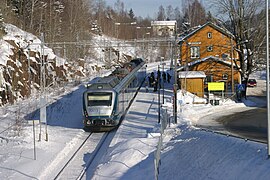Asker – Brakerøya railway line
| Asker – Brakerøya | |||||||||||||||||||||||||||||||||||||||||||||||||||||||||||||||||||||||||||||||||||||||||||||||||||||||||||||||||||||
|---|---|---|---|---|---|---|---|---|---|---|---|---|---|---|---|---|---|---|---|---|---|---|---|---|---|---|---|---|---|---|---|---|---|---|---|---|---|---|---|---|---|---|---|---|---|---|---|---|---|---|---|---|---|---|---|---|---|---|---|---|---|---|---|---|---|---|---|---|---|---|---|---|---|---|---|---|---|---|---|---|---|---|---|---|---|---|---|---|---|---|---|---|---|---|---|---|---|---|---|---|---|---|---|---|---|---|---|---|---|---|---|---|---|---|---|---|---|
|
Local train at Røyken station
| |||||||||||||||||||||||||||||||||||||||||||||||||||||||||||||||||||||||||||||||||||||||||||||||||||||||||||||||||||||
| Route length: | 27 km | ||||||||||||||||||||||||||||||||||||||||||||||||||||||||||||||||||||||||||||||||||||||||||||||||||||||||||||||||||||
| Gauge : | 1067 mm, from 1922 1435 mm | ||||||||||||||||||||||||||||||||||||||||||||||||||||||||||||||||||||||||||||||||||||||||||||||||||||||||||||||||||||
| Power system : | 15 kV 16.7 Hz ~ | ||||||||||||||||||||||||||||||||||||||||||||||||||||||||||||||||||||||||||||||||||||||||||||||||||||||||||||||||||||
| Maximum slope : | ø 11, max. at km 34,588 at Røyken 40 ‰ | ||||||||||||||||||||||||||||||||||||||||||||||||||||||||||||||||||||||||||||||||||||||||||||||||||||||||||||||||||||
|
|||||||||||||||||||||||||||||||||||||||||||||||||||||||||||||||||||||||||||||||||||||||||||||||||||||||||||||||||||||
The Asker – Brakerøya ( Spikkestadlinjen ) railway is a 27 km single-track, electrified Norwegian railway in the province of Viken , which runs from Asker to Brakerøya , a district of Drammen .
history
The line is part of the Gamle Drammenbanen ( German Old Drammen Railway), which was opened on June 3, 1872 with the gauge of 1067 mm and led from Oslo V to Drammen via Lierbyen .
King Charles IV (in Sweden Charles XV) wanted to hold the opening ceremony, so a royal crown with the initials CXV and the year 1872 was attached to a wall next to the station at Røyken station. However, the king died on September 18, 1872 and the opening was carried out by Statsråd Nils Vogt.
The line itself was built as a narrow-gauge railway with a gauge of 1067 mm and was expanded to standard gauge with a third rail between 1919 and 1922 . This was done so that the entire route could continue to be operated during the gauge changeover. During the same period, the line was electrified. This was completed on November 26, 1922.
The neighboring stations of Røyken were from 1885 the stop ( Norwegian Holdeplass ) Spikkestad , which was upgraded to a station from 1911. Another stop was built in Hallenskog in 1933 .
When the Lieråsen tunnel on the Drammenbane was opened in 1973 , all long-distance and freight traffic to Drammen was relocated to the new and shorter railway line. The new tunnel shortens the travel time between Oslo and Drammen by 45 minutes. The last train between Spikkestad and Brakerøya ran on June 2, 1973.
The old route was kept between Asker and Gullaug under the name Spikkestadlinjen . Gullaug was the end of the line until 1994, when freight traffic was shut down and the line to Spikkestad station was shortened. From here the local transport line L1 of the Norges Statsbaner runs between Spikkestad and Lillestrøm .
In 2012, the stops in Hallenskog and Åsåker were closed due to insufficient frequency, and Spikkestad was rebuilt in accordance with the relevant safety guidelines.
photos
Heggedal station with 69,047
Individual evidence
- ↑ Kilometers from Oslo S , previously from Oslo V
- ↑ Graphic timetable Oslo S – Drammen. (PDF) 2012, archived from the original on March 13, 2016 ; accessed on August 29, 2020 (Norwegian).
- ↑ Nils Vogt. In: Store norske leksikon . Retrieved June 1, 2020 (Norwegian).
- ^ L1 Spikkestad – Asker – Oslo S – Lillestrøm. banenor.no, accessed June 1, 2020 (Norwegian).
- ↑ Statsjonstruktur - Spikkestadbanen project. Jernbaneverket, March 1, 2012, accessed June 1, 2020 (Norwegian).



